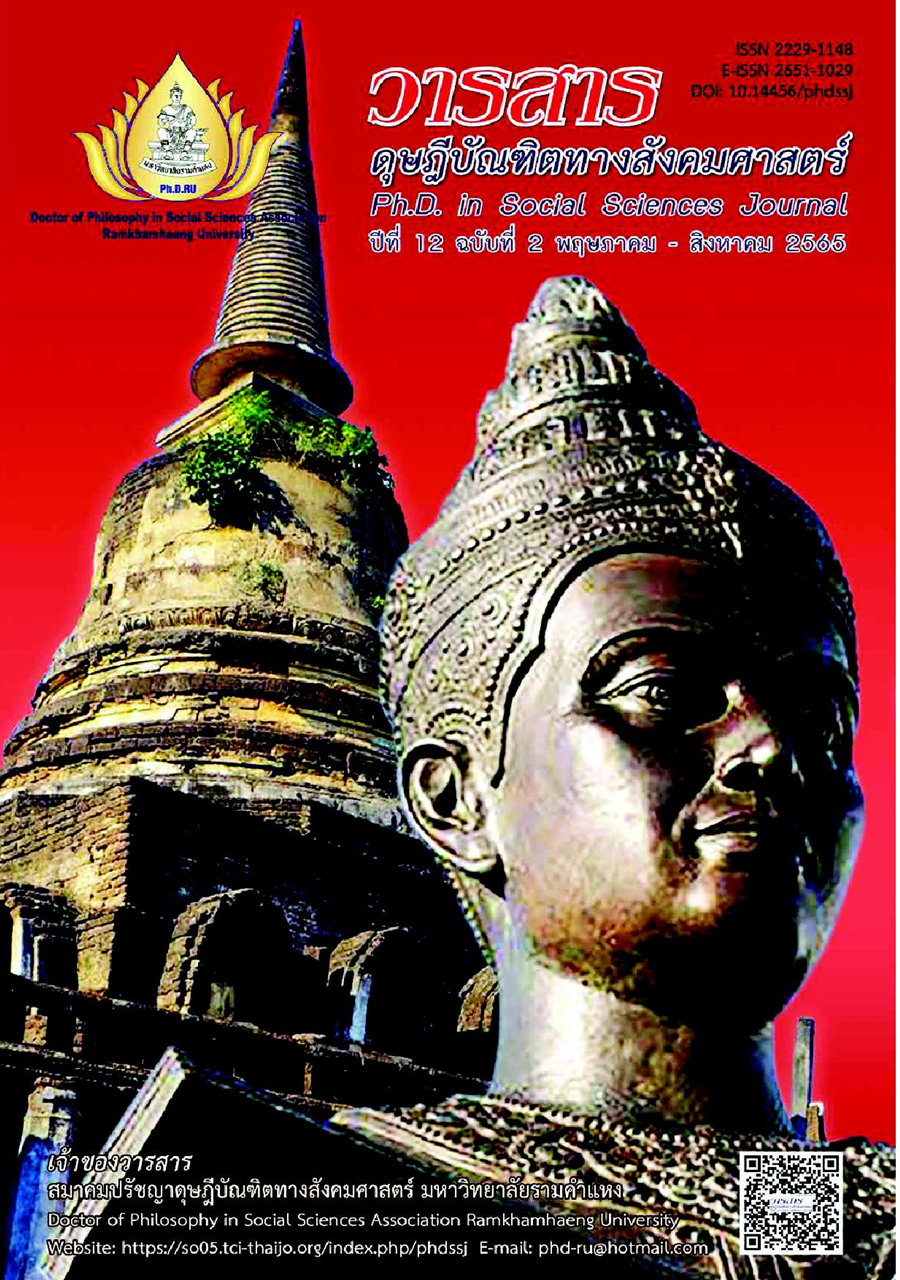The Causal Model of Students’ Decision to Drop-Out for Undergraduate Students: A Review
Main Article Content
Abstract
This academic article aims to analyze the factors related to students’ decision to drop-out to develop a causal relationship framework of factors affecting students’ decision to drop-out for Undergraduate Students in Thailand. To reduce, protect or deal with problems about students’ decision to drop-out and operational planning guidelines to support the development of undergraduate students of Thai Higher Education Institutions. The study was conducted by using a literature review and document analysis from 36 research papers between 2005 and 2020.
The analysis has found that academic integration, social integration and goal and institutional commitment had a direct relationship with students’ decision to drop-out. Besides, socioeconomic status, academic integration, social integration and goal and institutional commitment had an indirect relationship with students’ decision to drop-out.
Article Details

This work is licensed under a Creative Commons Attribution-NonCommercial-NoDerivatives 4.0 International License.
Academic articles, research articles, and book reviews in the Ph.D. in Social Sciences Journal are author’s opinions, and not the publisher’s, and is not the responsibility of the Ph.D. in Social Sciences Journal Philosophy Association, Ramkhamhaeng University. (In the case that research is done on human, the researcher has to be trained in Ethics for Doing Research on Human Training and has to produce the evidence of the training).
References
Adelman, C. (1999). Answers in the toolbox: Academic intensity, attendance patterns, and bachelor’s degree attainment. U.S. Department of Education, Office of Educational Research and Improvement.
Aitken, N. D. (1982). College student performance, satisfaction and retention: Specifi cation and estimation of a structural model. Journal of Higher Education, 53(1), 32-50.
Alivernini, F., & Lucidi, F. (2011). Relationship between social context, self-effi cacy, motivation, academic achievement, and intention to drop out of high school: A longitudinal study. The Journal of Educational Research, 104(4), 241-252.
Arce, M. E., Crespo, B., & Miguez-Alvarez, C. (2015). Higher education drop-out in Spain – Particular case of universities in Galicia. International Education Studies, 8(5), 247-264.
Bangmo, S. (2019). Organization and management. Se-Education. [In Thai]
Chantarakum, A. (2012). Development of an educational quality assurance procedure model for basic education schools. Doctoral Thesis of Education (Educational Administration), Kasetsart University. [In Thai]
Compan, P., & Apibunyopas, J. (2018). Causal model of dropout of students at Walailak University. Journal of Education Studies, 47(1). 240-262. [In Thai]
Eaton, S. B., & Bean, J. P. (1995). An approach/avoidance behavioral model of college student attrition. Research in Higher Education, 36(6), 617-645.
Glickman, C. D. (2003). Holding sacred ground: Essays on leadership, courage, and endurance in our schools. Jossey-Bass.
Internal Quality Assurance Committee. (2022). Manual for the internal quality assurance for higher education institutions Rajabhat University faculty and institute level (revised edition B.E. 2564). Chandrakasem Rajabhat University. [In Thai]
Karaked, N., & Kunakornviroon, V. (2015). Factors affecting the drop out of Rajamangala University of Technology Phra Nakhon students in 2014 academic year. Research Report, Rajamangala University of Technology Phra Nakhon. [In Thai]
Khampirat, B. (2013). Strategies and management systems for student retention at Suranaree University of Technology. Research Report, Suranaree University of Technology. [In Thai]
Lundberg, C. A. (2007). Student involvement and institutional commitment to diversity as predictors of Native American student learning. Journal of College Student Development, 48(4), 405-417.
Maldonado, D. E. Z., Rhoads, R., & Buenavista, T. L. (2005). The student-initiated retention project: Theoretical contributions and the role of self-empowerment. American Educational Research Journal, 42(4), 605-638.
Maslow, A. H. (1970). Motivation and personality (2nd ed.). Harper & Row.
Nora, A. (1987). Determinants of retention among Chicano college students: A structural model. Research in Higher Education, 26(1), 31-59.
Offi ce of the Education Council. (2017). National education plan B.E. 2560-2579. Retrieved from http://backoffice.onec.go.th/uploads/Book/1540-file.pdf [In Thai]
Offi ce of the National Education Commission. (2002). National education act B.E. 2542 and amendments (2nd) B.E. 2545. Retrieved from https://www.bic.moe.go.th/images/stories/5Porobor._2542pdf.pdf [In Thai]
Parker, A. (1999). A study of variables that predict dropout from distance education. International Journal of Educational Technology, 1(2), 1-10.
Phannarat, N., Wangrangsimakul, K., & Pipatpen, M. (2009). The problems of withdrawal of the youths receiving scholarship from world vision foundation of Thailand in Songkhla province. Princess of Narathiwas University Journal, 1(3), 130-144. [In Thai]
Phochchong, M., & Cheerapatdhanadhorn, P. (2020). Factors affecting dropout decision of vocational certifi cate students in Ayutthaya Vocational College. Mahachulagajasara Journal, 11(1), 36-47. [In Thai]
Spady, W. G. (1970). Dropouts from higher education: An interdisciplinary review and synthesis. Interchange, 1, 64-85.
Sungsri, S. (2017). A model of educational services to enable graduate students of Sukhothai Thammathirat Open University to achieve learning success in the distance education system. STOU Educational Journal, Sukhothai Thammathirat Open University, 10(2), 65-78. [In Thai]
Tinto, V. (1975). Dropout from higher education: A theoretical synthesis of recent research. Review of Educational Research, 45(1), 89-125.
Trakoolngam, W., Intraprasert, A., Intraprasert, S., & Rodpuang, J. (2007). Factors infl uencing of students’ drop out at Suan Dusit Rajabhat University. Research Report, Suan Dusit Rajabhat University. [In Thai]
Troelsen, R., & Laursen, P. F. (2014). Is drop-out from university dependent on national culture and policy?: The case of Denmark. European Journal of Education, 49(4), 484-496.
Vroom, V. H. (1964). Work and motivation. Wiley.
Watanaopas, P., Watanaopas, N., & Punjamas, N. (2005). Factors effecting on achievement motivation of students in Rajamangala University of Technology Suwanabhumi, Pranakhon Sri Ayutthaya, Wasukri Campus. Research Report, Rajamangala University of Technology Suwanabhumi. [In Thai]
Weng, F., Cheong, F., & Cheong, C. (2010). Modeling is student retention in Taiwan: Extending Tinto and Bean’s model with self-efficacy. Innovation in Teaching and Learning in Information and Computer Sciences, 9(2), 1-12.
Wilson, D. B., & Lipsey, M. W. (2001). The role of method in treatment effectiveness research: Evidence from meta-analysis. Psychological Methods, 6(4), 413-429.
Yongsorn, C. (2017). Educational waste affects the quality of graduates of Thai higher education. Journal of Education, Srinakharinwirot University, 18(1), 1-9. [In Thai]


